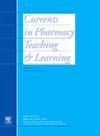Scaffolding a clinical debate assignment in an infectious disease pharmacy elective: A mixed methods analysis
IF 1.3
Q3 EDUCATION, SCIENTIFIC DISCIPLINES
引用次数: 0
Abstract
Objective
To evaluate the impact of instructional scaffolding on student performance and perceptions in a clinical debate activity within an infectious disease pharmacy elective course.
Methods
A sequential explanatory mixed-methods study was conducted from 2018 to 2022, involving pharmacy students enrolled in an infectious disease elective course. Students in the pre-scaffolding arm (2018) received traditional instruction, while those in the post-scaffolding arm (2019–2022) engaged in a scaffolded debate activity, comprising five milestone assignments and a mock debate. Student performance was assessed using group and individual debate rubrics. Student perceptions were evaluated through pre- and post-course surveys and thematic analysis of student reflections.
Results
Ninety-two students completed the elective (19 pre-scaffolding, 73 post-scaffolding). Group debate grades were higher in the post-scaffolding arm (median 94, interquartile range (IQR) [92,66] vs. 90 [90,91], p = 0.006), with no difference in individual debate grades. Students preferring debates/simulations had higher individual debate grades. Survey response rates were 100 % pre-course and 64 % post-course. Students in both arms reported increased confidence in defending clinical stances post-course, with higher confidence in the post-scaffolding arm. Qualitative results confirmed the debate activity as challenging, yet helpful in promoting communication, research, and professional skills.
Conclusion
Scaffolding a clinical debate activity increased student grades, confidence, and communication skills. These findings suggest that scaffolding can effectively enhance educational outcomes in pharmacy education. Further research should explore optimal scaffolding tasks and methods of scaffolding support.
在传染病药学选修课中组织临床辩论作业:混合方法分析
目的评价教学脚手架对学生在传染病药学选修课临床辩论活动中的表现和认知的影响。方法采用顺序解释性混合方法研究2018 - 2022年感染性疾病选修课药学专业学生。前支架组(2018年)的学生接受传统教学,后支架组(2019-2022年)的学生参与了支架辩论活动,包括五个里程碑作业和一次模拟辩论。学生的表现通过小组辩论和个人辩论来评估。通过课前和课后调查以及学生反思的专题分析来评估学生的看法。结果92名学生完成了选修课,其中支架前19名,支架后73名。支架后组的小组辩论成绩较高(中位数为94,四分位差(IQR)[92,66]对90 [90,91],p = 0.006),而个人辩论成绩无差异。喜欢辩论/模拟的学生的个人辩论成绩更高。调查回复率为课程前100%,课程后64%。两组的学生都报告了在课程结束后捍卫临床立场的信心增加,在支架后组的信心更高。定性结果证实辩论活动具有挑战性,但有助于促进交流,研究和专业技能。结论临床辩论搭建活动提高了学生的学习成绩、自信心和沟通能力。研究结果表明,在药学教育中,支架教学能有效提高教学效果。进一步的研究应探讨最佳的支架式支护任务和支架式支护方法。
本文章由计算机程序翻译,如有差异,请以英文原文为准。
求助全文
约1分钟内获得全文
求助全文
来源期刊

Currents in Pharmacy Teaching and Learning
EDUCATION, SCIENTIFIC DISCIPLINES-
CiteScore
2.10
自引率
16.70%
发文量
192
 求助内容:
求助内容: 应助结果提醒方式:
应助结果提醒方式:


